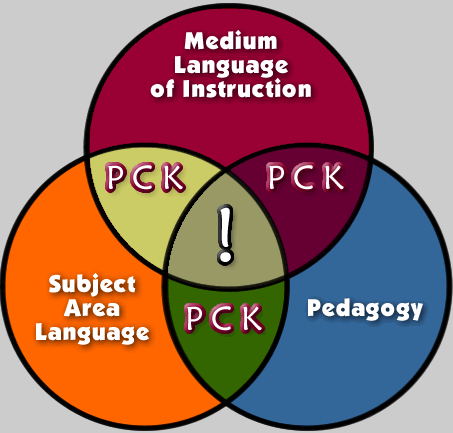 |
Learning Flourishes when Pedagogy
Merges with Content Knowledge.
 PCK 7-30-09
PCK 7-30-09
By Freddie A. Bowles
Posted from Fayetteville, Arkansas
Does expertise in one’s content area guarantee that a teacher can effectively teach that content to students?
Prior to the mid-1980s, teacher educators and other educational professionals most likely would have answered, “Yes.” It was thought then that content knowledge was sufficient for effective teaching. Likewise, if a teacher did not know the content of a particular subject, then it followed that the teacher could not teach the subject effectively. I also believed this. It wasn’t until I was a student in Dr. Mike Wavering’s “PCK” doctoral course that I became convinced that content knowledge was not enough to teach for learning.
A simple Venn diagram represents this concept nicely. The circle of Pedagogy and the circle of Content Knowledge intersect to create the region (union) of Pedagogical Content Knowledge. Successful teachers make this connection in their classrooms whether they know about PCK or not.
For many of us, the PCK connection reveals itself in one of those "ah-hah" moments when the positive signs of learning become immediately apparent. The teacher tries an activity or strategy, and then watches as students’ faces glow and heads nod in a burst of positive energy. Voila! We actually see learning happen.
A moment’s reflection shows us that PCK is not a new aspect of teaching, but now it has an academic identity, and a name that makes good sense to students of educational theory.
In the 1980s, researchers at the National Center for Research on Teacher Learning (NCRTL) found that subject-matter knowledge on the part of the teacher did not guarantee student learning (Ball, 1988; McDiarmid, Ball, & Anderson, 1989). A shift in thinking began to occur as researchers took into consideration the holistic context of the teacher-learner symbiosis.
The guru of PCK, Lee Shulman (1986), posited that content needed to be placed in relation to learners. Teachers needed to understand how to transform their content into techniques and practices that would make the subject comprehensible to others. Shulman believed a teacher should be able to identify the topics that are easy for students to learn as well as the topics that present special difficulties. A teacher must also be able to identify their students’ preconceptions and conceptions about the topics and how those views affect the learning process. The crux of the matter in Shulman’s approach is that teachers need to take positive steps to know and understand the background knowledge of their students. Teachers also need to know how background knowledge impacts their students' ability to learn.
Here’s an example to illustrate Shulman’s approach. In teaching a language, the instructor frequently addresses the topic of vocabulary. The teacher knows that cognates offer a proven way to build a student’s lexicon. However, in searching for a thorough treatment of the topic, the teacher would also have to consider false cognates and the challenges presented by overgeneralization of those deceptive words. Pedagogical Content Knowledge enters the picture when the teacher begins to reflect on the process. What do students already know about cognates? Should I teach false cognates? If so, when should I teach them in relation to other elements of the course of study? And finally, how should I teach cognates for effective student learning?
Yes, but.... Teaching a language from the viewpoint of PCK presents a unique set of challenges. Consider the obvious, that the subject matter of a foreign language class is the target language itself. But what if the language of instruction is the primary, or first, language of the students? How does the teacher reconcile the content of the two languages to produce learning?
If a student is learning Level I German in Arkansas, the language of instruction is most likely English with some German. It’s quite natural that English is the medium of instruction in most beginning classes of foreign language in the United States, where the subject-areas are usually the three most commonly taught languages: French, German, or Spanish. In this situation, a teacher must be well-versed in three areas: 1) the subject area language, for example, German; 2) the medium of instruction, which is English or a mix of English and German; and 3) the pedagogy for teaching German, the content language.
 In this case, rather than viewing PCK as a Venn diagram showing a simple union of content and pedagogy, let’s imagine it with three overlapping sets. PCK intersects with two languages, the subject area language and the medium language of instruction. The diagram reveals three areas of PCK. In our example, where German is the subject area language, we see the union of pedagogy for teaching German in the green zone, pedagogy for using English as the medium of instruction in the red zone, and pedagogy for using English to teach German in the yellow zone. Quite a challenge. The exclamation point represents student learning.
Another interesting consideration is the use of English as both the medium language of instruction and the subject area language. You might say to yourself, “Oh, an English class.” Yes, but....
A traditional “English” class, the kind that American kids are required to take every semester K-12, focuses on language arts — reading and writing, for the most part. But when the language of instruction is English for students who are learning the content as a second, or third language, you have another type of “English” class. When viewed in the context of PCK, ESL classes (English as a Second Language) present an odd situation in the realm of theory, and sometimes in actual practice. The teacher is using the content area to teach the content area. Think about that! The language is used to teach the language.
Regardless of the course and the medium of instruction — English in a foreign language classroom or English in a ESL language course — the goal for the teacher in both the foreign language and ESL classrooms is proficiency in a language for every student. For that reason, language education differs from instruction in other subject areas. The goal of a history class, for example, is not proficiency in a language, but expertise in a particular aspect of history.
Emergentist views of language present a formalized approach to the unique situation of foreign language education. Ellis and Larsen-Freeman (2006) view language as a dynamic system in which language proficiency emerges according to the learner’s use of resources, task-management, and outcome expectations. The Standards for Foreign Language Learning in the 21st Century (SFLL) outline proficiency guidelines in all skills of language learning: reading, writing, listening, and speaking. These guidelines address the dynamic process that builds proficiency.
Scaffolding instruction for a specific topic does not always increase proficiency. It may increase understanding of a concept or rule, but academic proficiency in a language emerges from practice within the context of the classroom. Let’s look again at the comparison-contrast to a history class. Like a language teacher, the history teacher scaffolds instruction to increase understanding of a concept or idea, but the history teacher’s goal is not to increase proficiency in language — although, in my opinion, language skills should be a consideration for all content area teachers.
Freeman, Orzulak, and Morrissey have created a “framework of language knowledge for/in teaching ... that combines knowledge of content and medium as these are enacted in and through processes of methodology.” Their framework expands upon Shulman’s construct (2009, p. 86).
The “emergent” framework consists of three components. Two independent components, content and methodology, are linked by a third component, medium. The content — knowing about language as content — and the methodology — knowing how to teach a language — represent two separate entities connected through the medium, which is the language that will be employed in teaching. The emerging framework from the teacher’s perspective also views language as a dynamic system. The teacher represents language as content in the act of teaching, a process that both uses language and creates language. In other words, language content emerges in the context of the classroom.
Regardless of the construct we choose, PCK or an Emergentist viewpoint, language knowledge alone is no longer sufficient for one to become an effective teacher. We also have to understand how to teach a language for student learning.
References
 Standards for foreign language learning: Preparing for the 21st century. (1993). Retrieved July 22, 2209, from http://www.actfl.org/ files/ public/ StandardsforFLLexecsumm_rev.pdf
Standards for foreign language learning: Preparing for the 21st century. (1993). Retrieved July 22, 2209, from http://www.actfl.org/ files/ public/ StandardsforFLLexecsumm_rev.pdf
 Ball, D. L. (1988). The subject matter preparation of prospective mathematics teachers: Challenging the myths. Research Report 88-3. National center for Research on Teacher Education. Michigan State University, East Lansing. Retrieved July 10, 2009, from http://ncrtl.msu.edu/ http/rreports/ html/rr883.htm
Ball, D. L. (1988). The subject matter preparation of prospective mathematics teachers: Challenging the myths. Research Report 88-3. National center for Research on Teacher Education. Michigan State University, East Lansing. Retrieved July 10, 2009, from http://ncrtl.msu.edu/ http/rreports/ html/rr883.htm
 McDiarmid, G. W., Ball, D. L, & Anderson, C. W. (1989). Why staying one chapter ahead doesn’t really work: Subject –specific pedagogy. In M. Reynolds (Ed.), The knowledge base for the beginning teacher. New York: Pergamon.
McDiarmid, G. W., Ball, D. L, & Anderson, C. W. (1989). Why staying one chapter ahead doesn’t really work: Subject –specific pedagogy. In M. Reynolds (Ed.), The knowledge base for the beginning teacher. New York: Pergamon.
 Ellis, N. C., & Larsen-Freeman, D. (2006). Language emergence: Implications for applied linguistics—introduction to the special issue. Applied Linguistics, 27(4), 558-589.
Ellis, N. C., & Larsen-Freeman, D. (2006). Language emergence: Implications for applied linguistics—introduction to the special issue. Applied Linguistics, 27(4), 558-589.
 Freeman, D., Orzulak, M. McB., & Morrissey, G. (2009). Assessment in second language teacher education. In A. Burns & J.C. Richards (Eds.), The Cambridge Guide to Second Language Teacher Education (pp. 77-90). Cambridge: Cambridge University Press.
Freeman, D., Orzulak, M. McB., & Morrissey, G. (2009). Assessment in second language teacher education. In A. Burns & J.C. Richards (Eds.), The Cambridge Guide to Second Language Teacher Education (pp. 77-90). Cambridge: Cambridge University Press.

 |
 |


Special
Methods
of Instruction
Multicultural
Issues
Classroom
Management
Concepts
Language
Development
for Educators
Classroom
Learning
Theory

Essays and Reports
by Dr. Bowles

The Association
of Teacher Educators
National Council
of Less Commonly
Taught Languages
LitTunes
Multicultural
Education
Resource Center
American Council
on the Teaching
of Foreign Languages
University of Arkansas
Curriculum and Instruction
Ron Fritze
Planet IEP
Teachers of English
to Speakers
of Other Languages
Planet Deutsch
American Association
of Teachers of German

Teaching People
of Other Cultures


|
 |


